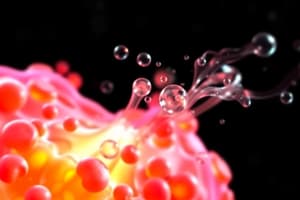Podcast
Questions and Answers
What is the direction of diffusion in a biological system?
What is the direction of diffusion in a biological system?
- From the inside compartment to the outside compartment
- From the outside compartment to the inside compartment
- From high concentration to low concentration (correct)
- From low concentration to high concentration
What is the term for the amount of gas diffusing per unit area of membrane per unit time?
What is the term for the amount of gas diffusing per unit area of membrane per unit time?
- Flux (correct)
- Diffusion coefficient
- Viscosity
- Concentration gradient
What determines the diffusion coefficient of a gas?
What determines the diffusion coefficient of a gas?
- Hydrophobicity of the gas molecule
- Concentration gradient across the membrane
- Temperature of the surroundings
- Size of the gas molecule and viscosity of the membrane (correct)
What is the result of diffusion in a biological system?
What is the result of diffusion in a biological system?
What is the equation that describes the process of diffusion?
What is the equation that describes the process of diffusion?
What is the role of energy in the process of diffusion?
What is the role of energy in the process of diffusion?
What is the concentration gradient in a well-mixed system?
What is the concentration gradient in a well-mixed system?
What happens to the concentration gradient over time in a biological system?
What happens to the concentration gradient over time in a biological system?
What is a necessary condition for biological gas exchange systems?
What is a necessary condition for biological gas exchange systems?
What is the effect of increasing the concentration gradient across the gas-exchanging surface?
What is the effect of increasing the concentration gradient across the gas-exchanging surface?
What is the effect of increasing the surface area of the gas-exchanging surface?
What is the effect of increasing the surface area of the gas-exchanging surface?
Why do single-celled organisms not require specialized gas exchange surfaces?
Why do single-celled organisms not require specialized gas exchange surfaces?
What is the relationship between the volume of a unicellular organism and its gas exchange needs?
What is the relationship between the volume of a unicellular organism and its gas exchange needs?
What happens to the surface area to volume ratio of an organism as it increases in size?
What happens to the surface area to volume ratio of an organism as it increases in size?
What is the formula for the amount of gas diffusing per unit time?
What is the formula for the amount of gas diffusing per unit time?
Why do larger organisms require specialized gas exchange surfaces?
Why do larger organisms require specialized gas exchange surfaces?
Flashcards are hidden until you start studying
Study Notes
Diffusion and Surface Area
- Diffusion occurs down a concentration gradient, with gas molecules moving from high to low concentration.
- It is a passive process, requiring no energy, and follows Fick's Law.
- Fick's Law states that the flux (J) is equal to the diffusion coefficient (D) multiplied by the concentration gradient (dφ/dx) across the membrane.
Factors Affecting Diffusion
- The diffusion coefficient (D) varies depending on the gas molecule size and membrane properties (viscosity, temperature, and hydrophobicity).
- The concentration gradient (dφ/dx) affects the rate of diffusion, with higher gradients resulting in faster diffusion.
- The thickness of the gas-exchanging surface also affects the rate of diffusion, with thinner surfaces allowing for faster diffusion.
Importance of Surface Area
- An increase in the available surface area increases the amount of gas that can diffuse in a given time.
- The amount of gas diffusing per unit time (dq/dt) is the product of the flux (J) and the surface area (A).
- Single-celled organisms have a high surface area to volume ratio, making their cell membrane adequate for gas exchange needs.
- As an organism increases in size, its surface area becomes inadequate for its gas-exchange needs, requiring specialized gas exchange surfaces.
Studying That Suits You
Use AI to generate personalized quizzes and flashcards to suit your learning preferences.




